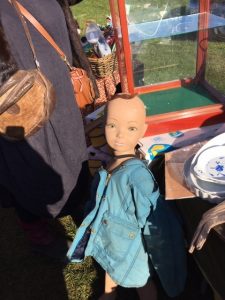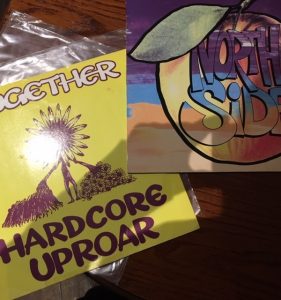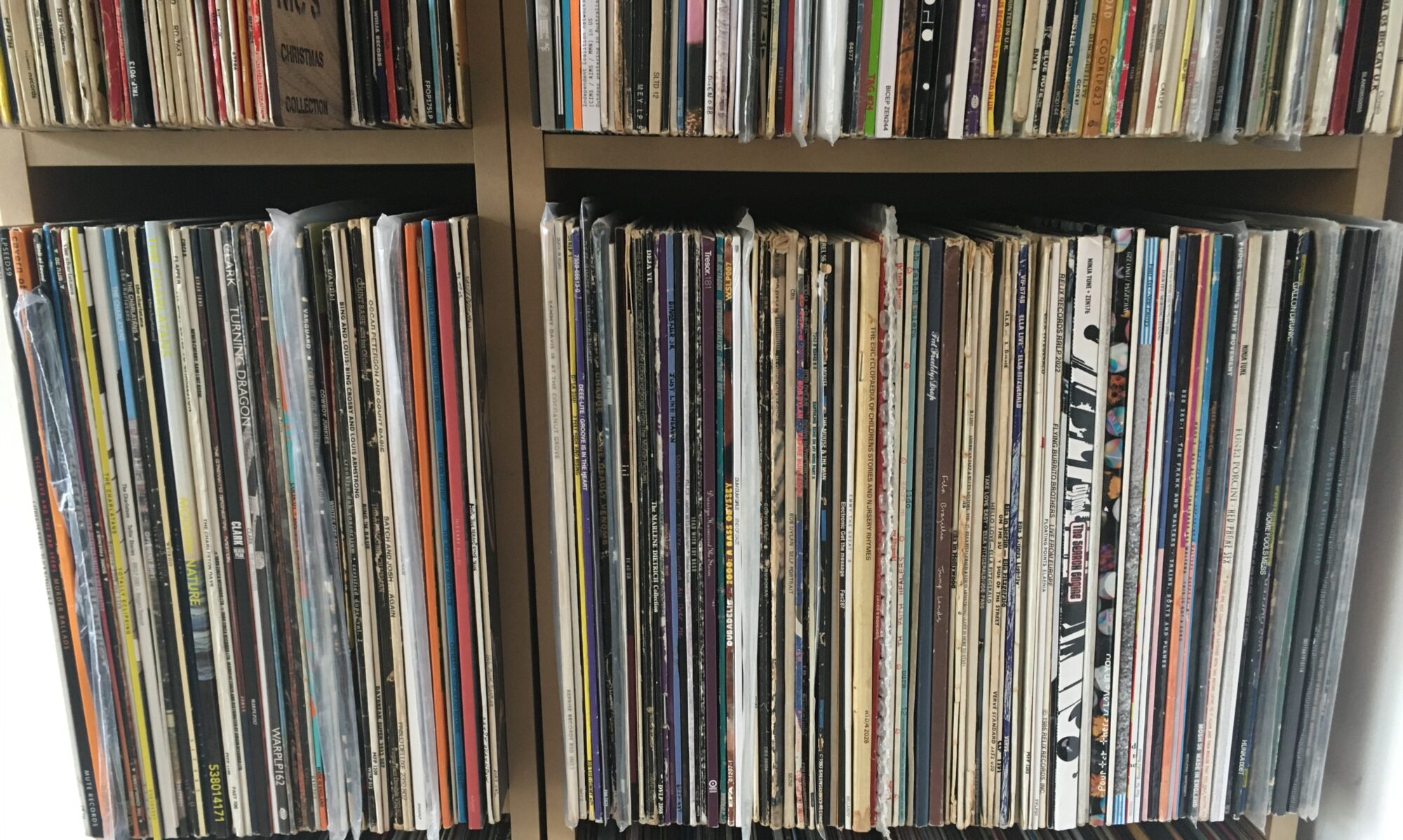Crate Digging
Saturday mornings in the spring and summer are most definitely car boot mornings. Me and my awesome wife Nic struggle out of bed at the crack of dawn (why do they start so early? I’ve never been given a decent answer to this crucial question.), inhale a pint of coffee and walk across York to the car boot sale at the racecourse. It is a weird and wonderful place (read Nic’s own take on this here) and perfect for realising not only that there is cash to be made from strange old tat but also that the stuff itself, in its strangely jumbled piles, is the material of trippy fever dreams.


I go there for old records. I would like to claim that I am looking for elusive old jazz records or arcane field recordings à la Cecil Sharp. But, those would be lies. I like buying old indie records and I like buying old rave records. Anything from Madchester, Seattle, the Thames Valley shoegazers or the holy Stourbridge trinity (well not the Wonderstuff really – far too earnest) will do. I like the sleeves to tell a bit of a story. Old Our Price stickers, tony burns, property of John (aged 14) scrawled in biro. I also like it when old gig tickets tumble out along with the record itself. An Inspirals ticket from 1991 inside Fudge Tunnel’s Hate Songs in E Minor was a particularly dissonant example of this (the gig was four quid BTW – This is How it Feels to get a bargain).
So, this weekend was the first such event of the year and the vinyl itch was ready to be scratched. The problem is that it’s getting harder and harder to do this. The so-called ‘vinyl revolution’ has ruined everything. Crate digging at car boots used to mean searching through mounds of dross (mostly copes of No Parlez and No Jacket Required plus weirdly high numbers of Alan Parsons Project LPs) until you hit gold. I have found a copy of ‘LFO’ by LFO (in a tatty old Warp purple sleeve) for 50p, ‘Pac-Man’ by Power Pills (Aphex’s muckabout-but-still-great contribution to toy-town rave) for a quid, countless Neds, Charlatans, PWEI and Dinosaur Jr twelves for next to nothing. That’s changing now though. You can spot the traders clutching ipads logged in to Discogs and ready to charge maximum online value. You can spot the traders who think they are at a record fair. What these chancers forget is that they are in a field and that their records are not what you would describe as mint. The funny thing is that they are selling much better records (no need to sift through the crap) but charging way too much for them. I used to take 20 notes with me, buy a stack of maybe 10 records and still come away with enough for a post-boot sale jar. Not any more.
But this weekend was OK. I got two records that fit the bill and will add weight to my groaning shelves. Northside’s ‘Rising Star’ and Together’s ‘Hardcore Uproar’. Four quid each. Reasonable nick. These are two sides of the same coin. One baggy indie and one baggy rave. The sort of tunes that only ever appear in the middle of a regional scene that is at maximum hype velocity. Both sound, shall we say, of their time. This doesn’t matter though as I, to misquote Kurt Vonnegut, am an old fart with his records and unreliable memories.

Catching Up
Like lots of people, my oldest of old friendships are rooted in music. Getting together with childhood buddies usually involves spinning the old records until it’s far too late at night and the neighbours are getting narky. When it’s my mate Ian, the top three usually goes: ‘Words that Say’ by Mega City Four, the whole of God Fodder by Neds and ‘Shall We Take a Trip’ by Northside (yep, them again). So, newly emboldened by WhatsApp (only about five years after everybody else), I sent him photos of my car boot purchases. This sparked a day long natter about all things Madchester.
Let me set up our love for baggy. We grew up in the south and were basically too young to really get involved with raving. Manchester for us was entirely constructed by the NME, the Word and those infamous TOTP appearances where bands would mime badly and be wearing their outside coats. It was an illusion but one that we wholeheartedly believed in from the other end of the country. We also loved Shoegaze and the Stourbridge scene and it was these bands we saw when we were finally old enough to go into London (or brave enough to lie to our parents anyway). But Manchester, the Hacienda, Eastern Bloc Records and Afflecks Palace all remained out of reach.
Manchester was a mirage and an imaginary land. Its characters were exaggerated and mythic. Tony Wilson the besuited provocateur, the mumbling enigma that was Ian Brown, the legendary tales of noble inebriation that came out of the Mondays camp. All of this was perfect narrative. We didn’t really care about Lord of the Rings and Harry Potter was still only a flicker in JK’s imagination. This legion of indie groovers in their Joe Bloggs armour were our Quixotic heroes.
They still are.
‘They play the platter, I do the chatter’
The stories told are plural and multifarious. Like any process of mythogenesis, there are contradictions, liminalities and ambiguities. But, for me and Ian, all of this chaos is encapsulated in one hour of grainy VHS (although for this post I watched it on YouTube). Granada TV’s 1990 documentary Madchester: The Sound of the North is truly bonkers. We used to watch it round Ian’s house. Usually on a Sunday morning after a cider induced ‘sleepover’. We could quote it verbatim then and still can now.
It really is an odd beast. It is a celebration of Manc modernism, a rejection of easy stereotypes, a big old show off for genuine talent and a simultaneous and self-conscious rejection of all of these things. Witness the arch parody of travel-guide TV enacted by not-at-all-smug-or-self-important NME journalists Stuart Maconie (complete with hilarious wedge hair-do) and James Brown (yes, he of Loaded magazine fame and all the associated horrors of ‘new laddism’). They explore the steel and glass interiors of new nightspots and the enclaves of Afflecks Palace, show us around the NME offices during the front cover decision discussion (‘Shaun to be Wild’? really?!) and even accompany the Mondays to Amsterdam (can you spell j-o-l-l-y James?). Their stab at postmodern humour is, as well as grating in the extreme, an attempt at exposing the metanarrative at work and exposing the nuts and bolts of creating hype.
Much more fun (and much less irritating) are the features on the musicians and DJs themselves. Northside allow the cameras in to watch them rehearse their new ‘love song’ (and of course my new old car boot purchase) ‘Rising Star’ They seem totally in love with playing and can’t believe that their new hobby is now getting so much mileage. Signed to Factory after only 10 gigs, they reflect on the fact that two years previously Manchester had been ‘all about football hooligans’ but now everyone is more ‘relaxed’. Clint Boon and Tom Hingley of Inspiral Carpets fame explain the concepts for their ‘This is How it Feels’ video and seem happy that their parents are pretty pleased with their success. 808 State and MC ‘pump some lyrics’ Tunes are great company. As Tunes explains, they ‘play the platter and I do the chatter’. Their ‘machine sounds’ show the ways that US house and techno have infused Manchester’s punk and indie spirit and created something unique. This becomes even clearer when A Guy Called Gerald visits Detroit to remix his material with Derrick May, ‘taking the cream to the cat’, as he terms it. Amongst all of the self-aggrandising that always seems to exist alongside a scene like this, these sections of the documentary are an important reminder that the music has to be this good in the first place.
As a nostalgic sort (and in keeping with the themes of this blog and our research), it is the extramusical ephemera that particularly catches my eye. The Joe Bloggs man grabbing massive jeans off the rails in his shop (‘biggest flares in the world!), the team at Central Station Design (responsible for much of the Mondays aesthetic) making collages out of old photos and football stickers before going full Jackson Pollock with the paint tins, the creators of fanzine Freaky Dancing capturing the ‘summer of love’ in comic art form and DTP. All of these wonderful and eccentric cultural artefacts are the oxygen of the scene. They supply wit and genuine fandom. It is, of course, a scene where art and commerce collide, this was always central to Tony Wilson’s credo. But these fans and their superb creativity are an antidote to the short-termism of the record company execs from WEA who talk in terms of units and commercial potential. Yes, I know that this stuff has to be a product and without these men I would never have heard the music in the first place and blah, blah, blah. But I can still think they look and talk like wankers. I know that Joe Bloggs jeans look ridiculous now, but they are still better than fucking chinos.
The documentary is odd in that it knows its nostalgic value despite the fact that is made during the heat of the scene. It is laying down its narrative as if knowing that this will be a fleeting moment. The final sections show the huge Mondays gig at the G-Mex. The event is described as the band’s ‘coming of age’. Is this legitimacy for the music? For its commercial value? Is this official beginning also a sort of end? Well, the final word goes to the NME team who play with the idea of their power. They stop short of stroking a white cat and hovering a finger over a red button, but you do get the sense that they are intoxicated with their status as gatekeepers. They deny that they create scenes just to destroy them, but, we were all there right? We remember. I still feel sorry for Slowdive.
Now that all of this musical stuff exists in museums and the bands are on reunion tours, this documentary is a reminder of how great the music was and how active fans were in the pre-digital age. It is funny, weird and brilliant. Get your flares on and have a watch. It is, in the estimable words of MC Tunes, a ‘banging’ way to spend your lunch hour.
The older I get the more I realise that culture is both caught in a moment and eternal. Yes, buying records at a car boot is probably central to my ongoing mid-life crisis but it is also a way to see music and all that surrounds it as still physically and psychologically on-the-move. The stories are rooted in time and place but they are also open-ended and dialogic. I have the same conversations now as I did 20 odd years ago but the tone changes. Memory is both past and present. It roots your personal history but it shapes your present too. I don’t want time to stand still and I don’t want to buy pre-packaged versions of the past. I like that the car boot records wear their narrative on the tattered sleeves. I like to think that I do the same.

